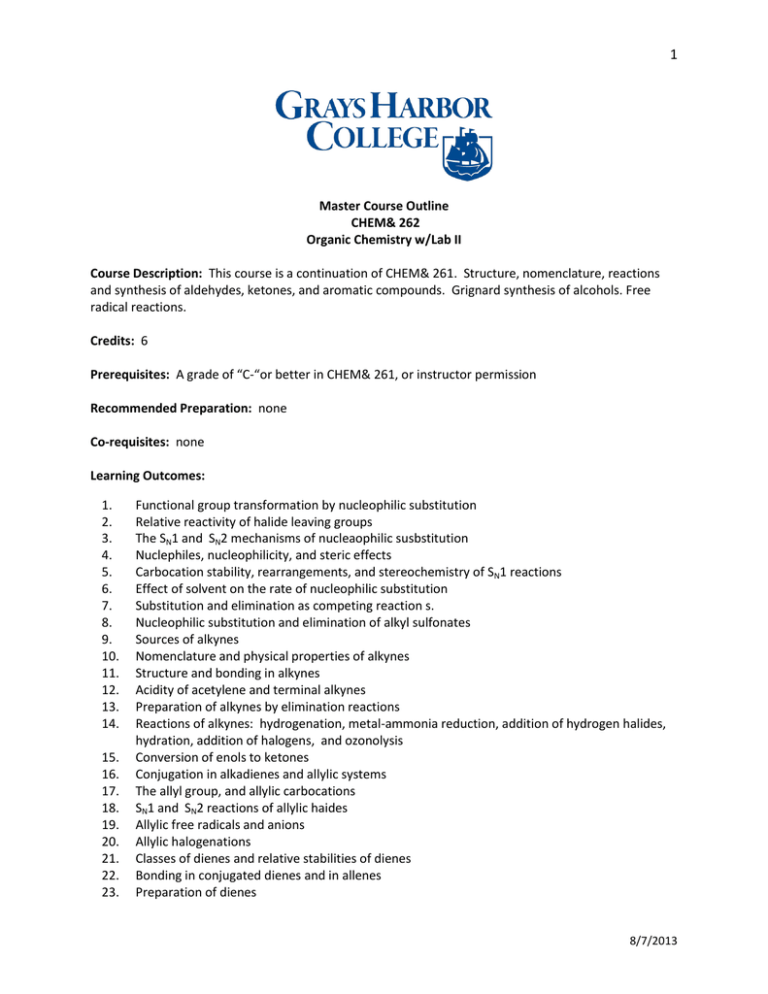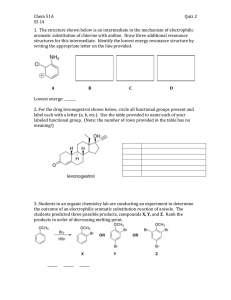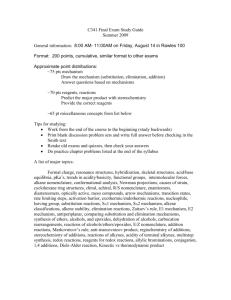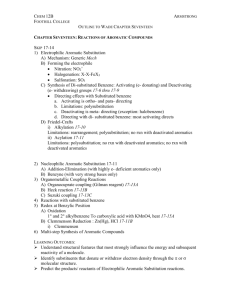1
advertisement

1 Master Course Outline CHEM& 262 Organic Chemistry w/Lab II Course Description: This course is a continuation of CHEM& 261. Structure, nomenclature, reactions and synthesis of aldehydes, ketones, and aromatic compounds. Grignard synthesis of alcohols. Free radical reactions. Credits: 6 Prerequisites: A grade of “C-“or better in CHEM& 261, or instructor permission Recommended Preparation: none Co-requisites: none Learning Outcomes: 1. 2. 3. 4. 5. 6. 7. 8. 9. 10. 11. 12. 13. 14. 15. 16. 17. 18. 19. 20. 21. 22. 23. Functional group transformation by nucleophilic substitution Relative reactivity of halide leaving groups The SN1 and SN2 mechanisms of nucleaophilic susbstitution Nuclephiles, nucleophilicity, and steric effects Carbocation stability, rearrangements, and stereochemistry of SN1 reactions Effect of solvent on the rate of nucleophilic substitution Substitution and elimination as competing reaction s. Nucleophilic substitution and elimination of alkyl sulfonates Sources of alkynes Nomenclature and physical properties of alkynes Structure and bonding in alkynes Acidity of acetylene and terminal alkynes Preparation of alkynes by elimination reactions Reactions of alkynes: hydrogenation, metal-ammonia reduction, addition of hydrogen halides, hydration, addition of halogens, and ozonolysis Conversion of enols to ketones Conjugation in alkadienes and allylic systems The allyl group, and allylic carbocations SN1 and SN2 reactions of allylic haides Allylic free radicals and anions Allylic halogenations Classes of dienes and relative stabilities of dienes Bonding in conjugated dienes and in allenes Preparation of dienes 8/7/2013 2 24. 25. 26. 27. 28. 29. 30. 31. 32. 33. 34. 35. 36. 37. 38. 39. 40. 41. 42. 43. 44. 45. 46. 47. 48. 49. 50. 51. 52. 53. 54. 55. 56. 57. 58. 59. 60. 61. 62. 63. 64. 65. 66. Reactions of dienes: addition of hydrogen halides to conjugated dienes, halogen addition to dienes, Diels-Alder reaction molecular orbital analysis of the Diels-Alder reaction The structure and stability of benzene Orbital hybridization and molecular orbitals of benzene Substituted derivatives of benzene and their nomenclature PAH’s Physical properties of arenes Reactions of arenes: Birch reduction, free-radical halogenations of alkylbenzenes, oxidation of alkylbenzenes SN1 and SN2 reactions of benzylic halides Preparation of alkenylbenzenes Addition reactions of alkenylbenzenes Free-radical polymeriztion Cyclobutadiene and cyclooctatetrene Hückel’s Rule Annulkenes Aromatic ions Heterocyclic Aromatic Compounds and Hückel’s Rule Representative Electrophilic Aromatic Substitution reactions of benzene: nitration, sulfonation, halogenation, bromination, Friedel-Crafts alkylation and acylation Synthesis of alkylbenzenes by acylation-reduction Rate and Regioselectivity of in Electrophilic Aromatic Substitution Substituent effects in Electrophilic Aromatic Substitution Multiple substituent effects in Electrophilic Aromatic Substitution Substitution in heterocyclic aromatic compounds Nucleophilic aromatic substitution The addition-elimination mechanism of nucleophilic aromatic substitution Related nucleophilic aromatic substitution Introduction to IR pectroscopy Characteristic absorption frequencies UV-VIS spectroscopy Mass spectroscopy Molecular formula as a clue to structure Organometallic nomenclature Carbon-metal bonds in organometallic compounds Preparation of organolithium and organomagnesum compounds: Grignard reagents Organolithium and organomagnesum compounds as Brønsted bases Synthesis of alcohols using Grignard reagents, and organolithium reagents Retrosynthetic analysis Alkane synthesis using organocopper reagents Lithium dialkylcuprates Transition metal organometallic compounds Sources of alcohols Preparation of alcohols by: reduction of aldehydes and ketones, reduction of carboxylic acids, epoxides Preparation of diols 8/7/2013 3 67. 68. 69. 70. 71. 72. 73. 74. 75. 76. Reactions of alcohols: conversion to ethers, esterification, xidation, including biological and DMSO oxidation Oxidative cleavage of vicinal diols Nomenclature of ethers, and epoxides Structure and bonding in ethers and epoxides Physical properties of ethers Preparation of ethers: Williamson Ether synthesis Acid catalyzed cleavage of ethers Preparation of epoxides by conversion of vicinal halohydrins Reactions of epoxieds: nucleophilic ring opening, acid-catalyzed ring opening Epoxides in biological processes Course Resources/Textbooks/Website: These textbooks are required for this course as well as the beginning course of the sequence, CHEM 261, and are used for the remaining course in this sequence, CHEM 263 Organic Chemistry, 8th Edition, Frances Carey and Robert Guiliano, McGraw Hill, ISBN: 987-0-07-340261-1 Organic Chemistry Laboratory Manual, , 3rd Edition, Anne Padías, Hayden McNeil, ISBN: 978-0-7380-3748-6 Making the Connection2, A How-To Guide for Organic Chemistry Lab Techniques, Anne Padías, Hayden McNeil, ISBN: 978-1-4292-8812-5 Students are also required to purchase an Organic Chemistry Laboratory Notebook, Hayden McNeil, ISBN: 978-1-930882-46-1 Other ancillary materials are available from the publisher such as Student Solution Manuals which, is recommended but is optional. If you have questions about the text, please contact Julie Nelson at jnelson@ghc.edu. These items are all available at the GHC Bookstore. Academic Integrity: All forms of cheating, falsification, and plagiarism are against the rules of this course and of Grays Harbor College. Students who are unsure what constitutes academic dishonesty are responsible for asking the instructor for clarification. Instances of intentional academic dishonesty will be dealt with severely. Disabilities: Students who have documented disabilities that require accommodations in compliance with the Americans with Disabilities Act should contact the Disability Support Services coordinator as well as the instructor of the course in order to ensure that together we create an optimal environment for educational achievement. W Day, the final day to officially withdraw from a course, is the Thursday of the seventh week (Thursday of the fourth week for summer quarter). Students who do not withdraw by that date will receive the grades they have earned, regardless of whether they are attending the course or completing the work. Students who are considering withdrawal are strongly advised to consult with the instructor, advisor and financial aid prior to withdrawing. The only withdrawals allowed after W Day are complete withdrawals from all courses. 8/7/2013




